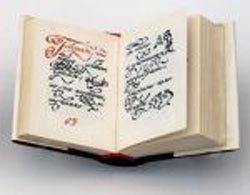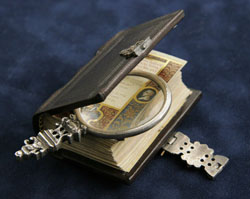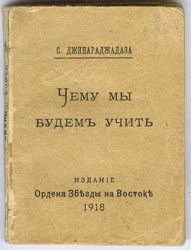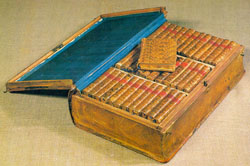Miniature book: past, present and future.
Historians of miniature books keep on remembering previous forms of its existence – small clay planches made in Babylon more than 4000 years ago. So what is miniature book like? There’s no single definition. In USSR and now in Russia miniature book is an edition (in cover or in bookbinding), with maximum book face not more than 100 mm. The format of a book is pointed in mm, first number means breadth, second – height of edition. In other countries (USA, Great Britain, Germany, Hungary) these standards can’t surpass 3 inches, e.g. 76 mm. However among miniature books can be noticed micro-books which are even smaller 76. Notorious peculiarity of micro-book is no doubt, it’s size (not more than 10х10 mm), inability to read it with unarmed eye could be also pointed out, but everybody has different eye-vision! Invented in second half of XIX century photomechanical reproduction has made the opportunity to degrade text almost limitless.
The fancy thing about miniature book is the fact that despite its small size it possesses all the features of the Book- the greatest of all treasures in human wisdom, reservoir of human genuine, and this fact compensates difficult and complicated work of saving and multiplying miniature books.
History of miniature book
Take big book to storage, buy such of a hand size
Marcial, Roman poet.
From the ancient history is known the example of Pliny the senior. His “Natural History in 37 books” mentioned Homer’s “Iliad” whose text consisting of 15686 poems managed on a tiny piece of parchment paper put into a nut shell.
There exists paper scroll “Dharani” of 57mm breadth with Chinese pray on it dated 770 AC. Miniature scroll with characters printed with wooden block was put in a wooden pagoda-form box. It was made by command of Japanese empress in order of popularizing Buddhism in China.
When scientists were working on a dig in Novgorod they found birchbark manuscripts of XIII century among them were miniature documents with prayers texts, including ABC.
Nowadays book specialists can’t give a certain definition of “book”. Besides classical “codex” from there’re scroll and a number of bases tied in a fan-fold form. Books made of plastics, metal foil and other unusual materials (the usual one is paper made up for papyrus, parchment) have appeared lately!
History:
• In Medieval the most popular handwriting books were “Books of Common Prayer”, “Bibles”. Due to high cost (the labor was hard and diligent) only rich people could afford them. Many hand-painted books-manuscripts were written on order of nobleman, aristocracy and members of Royal families.
• NY Metropolitan Museum preserves “Horologium” (настольная книга) the book of Jeanne d’Evre created by order of French monarch Carl IV by Parisian masters in 1325-1328. The book 60х90 mm has brown skin binding with metallic snaps, severe but at the same time beautiful gold lettering on cover and back, triple gold edge. 418 pages boast 25 gold illuminated color miniatures.
• In Matenadaran (Erevan) is preserved handwriting book 30х40 mm, dated by 1434 year. Main principles of calendar theory are calligraphically written on 104 parchment pages by writer Oxen from city of Kafa (Crimea).
• Madrid safekeeps “Horlogium of Lorenzo Medici” of XVI century – the renown chef-d’oeuvre of Renaissaince masters father and son Boccardino and Stefano di Tommazo Giovanni. Book of 40х50mm size in skin binding with silver lock has numerous miniatures, pages are decorated with fancy ornaments. This book is a wedding present from Cardinal Giovanni Medici to his nephew Lorenzo Medici.
• History knows the examples of working out slideable clay script letters (China, XI century), wood and cuprum (Korea, XIII century).
• After Joganne Gutenberg (Mainz, Germany) in the middle of XV century invented artificial script – slideable metal letter (specialists consider Conrad Zaspah to be one of the inventors of first printing machine!) geography of printing and distributing books including miniature ones has (Germany, Netherlands, Italy, France, England, Belgium). Circulation of incunabula accounted for hundreds and thousands copies. Gerard Leu, Peters Os van Bred and the Elzevires, whole family of typographers added to Netherlands world fame.
• Now the earliest printed miniature book is said to be “Dirunale Moguntinum” of 1468 year, 65х94mm, the fragments are conserved in Paris National Library. Guttenberg’s apprentice and successor Peter Sheffer had printed the book in small gothic script.
• “Various consumes” (Venice, 1572 year) is considered to be first Slavic miniature book in Cyrillic script. Book of 70х95mm size was printed by Yakov Kraikov (from Sofia); it is an album with printed Menology (or Church Calendar); guide of Venice sacred sites; different prayer books and songs, Apocrypha and ecclesiastical calendars. Nowadays unique complete calendar ( one of three known copies) is kept by Leiden’s (Netherlands) University Library.
• Aldus Pius Manutius had printed in his Venice publishing house (“Aldus’s house”) works of ancient writers, among them were pocket books. Books typesetting (over 1100 “aldin”), was mainly organized from handwriting originals!
Painter of “Aldus’s house” Francesco da Bolonya introduced italic type!
• “Books of prayers”, “Church Calendars”, “Menologies” as well as various calendars and advice to travelers, e.g. real books were very popular in Russia. First printed miniature book in Russia is “Menology”, issued by Vasiliy Burtcov in Moscow Printed House in 1639 . The edition consists of seventeen 8-list copy-books 71х97mm. 136 lists of “tercia” script are not numerated. Three of seven known examples are saved in St Petersburg, others four- in Moscow.
• Only in 1690 in New World (Boston) first American miniature book (96 pages, 49х 73 mm). It was William Secker’s “A Wedding Ring, Fit for the Finger…” Samuel Green, typographer printed this book for his friend, editor Benjamin Harris.
• In XVII-XVIII centuries miniature books were gaining popularity in England and France, whereas along with prayers and bibles, poetics with historical manuscripts and Shakespeare’ books began issued.
• In XIX century dictionaries, almanacs, poetic albums became hot. Expensive skin, pearl, tortoise bone, silver, gold as well as paper and carton were used for bookbinding.
• Russia wasn’t far behind her Eastern and Western neighbors. Library of Russian tsars no doubt had handwriting miniature book of XVII century – “Church calendars” 48х74 mm, is now preserved by library of Russian Academy of Science (St Petersburg).
• First massive publishing of miniature books in paperback was organized in Russia in the end of XIX century. From 1891 to 1895 “South-Russian publishing house of F.A. Ioganson” (Kiev, Kharkov) issued over 300 copies of 55x73 mm to 60x80 mm size books in paperbacks. Circulation of some books reached 5000 examples, total circulation of library “KROSHKA” accounted for 2mln copies. The editor offered books in hard-covers for aesthets.
In the end of XIX – beginning of XX centuries due to such editors as M.Shaultz (Warsaw), A.Suvorin (Moscow) and others Russian Empire issued much more mini-books. Books with writings of A.S. Pushkin have gained great popularity. Warsaw editor M.Shaultz organized photomechanical printing of miniature books. In 1898 to commemorate 100-year jubilee of A.Mitckevich PH issued 19х29mm book of his lyrics. Exclusive variant included silver boxes (ordinary tin boxes were also available) in the form of chain-let bear-lock with loupe and lock.
To A.S. Pushkin jubilee in 1899 the same company published his two books – “Evgeny Onegin” and “All Pushkin poems”. Size of the book was 17х26 mm, 268 pages.
• In the beginning of XX century Synodal typography began printing large circulations of miniature books.
• The premier Soviet miniature book is the one issued in Petrograd in 1918 edition of Oriental Star medal “What we are going to teach” by S.Ginarjadaz. In those years Russian Theosophic Society managed to issue a complete library – over ten miniature paperback books!
• In pre-war and war time miniature books accounted for large circulations in party and specialized publishing houses (“Partizdat CK VKP (b)”, “Politizdat”, “Detgiz”, “Detizdat CK VLKSM”, “Literature for children”, “Novel literature”, “Molodaya gvardia”).
In 1978 even specialized editorials for miniature books appeared in Moscow PH “Kniga” and Permian book editorial house. After 1985 edition of miniature books suffered one of the hardest crisis, its quality and circulation dramatically decreased. Nevertheless, fans of this edition were trying gradually to improve the situation.
Nowadays there are over hundred PHs specialized in printing miniature books in the world. One of the largest with circulation around 10 thousand copies and hundred items are: “Running Press” (USA-Great Britain); “Miniature Edition” and “Ariel Books. Andrews and McMeel” (USA); “Los Libros Mas Pequenos Del Mundo” (Peru); “Bonsai” (Argentina); in Germany – “Leipzig.Miniaturbuchverlag”, “arsEdition”, “Wilhelm Heyne Verlag” and “Dietz Verlag”; “Legnano.EdiCart” (Italy); “Egmont Children`s Books” (Great Britain); “BIOTOP” (France).
Among CIS PHs are “Harvest” (Belarus); “Novel literature”, “Fond of I.D. Sytin”, “Russian raritet” and “YanikO” in Moscow. Few tens of private editors issue miniature books with circulation of 30-100 copies. Rare are masters creating high quality handwriting books. American calligrapher Shannon Mitchell has made over 130 items of handwriting miniature books in different languages which are all masterpieces! Her circulation is often 1-22 copy. Answering her request I send her an article “Initials of XI-XVI centuries”, unfortunately she didn’t manage to make a Russian copy for me.
To begin from 80-s in many countries (Spain, Germany, Italy, Switzerland, Austria, Australia, USSR) have opened publishing houses specialized in issuing facsimile editions. Due to various reasons (time, wars, fires, floods) only few of a large extent of handwriting books from first centuries of the second millennium have been saved. Peculiar technique made it possible to restore rare handwriting and printing books among them rare miniature illustrated handwriting books. One of such examples is the smallest book in Vatican library “The correspondence of St Francis and St Anne” (25х35 mm). The original was written in Latin in the beginning of XIII century.
• Micro-editions (less than10 mm) became the hot subject in the beginning of XX century, although already in 1674 Dutchmen Benedikt Smidt typed and printed miniaturebook of 12х8 mm size. It was the lyrics of Dutch poet van Lange called “Tiny flower garden” (C.van Lange, “Bloem Hofje Dor”). It consists of 49 pages, circulation has not been identified, only few copies are conserved.
• In 1985 first Soviet micro-book “Miracles of miracles” 6х9mm, issued by PH “Book”. Printed by Podolsk litho printing fabrics its circulation accounted for 200 copies. Besides micro-book (“daughter”) enlarged variant (“mother”) was printed 31х45mm. On the 24-page book text about the book by A.S. Pushkin and M.Gorky with their portraits was printed in five languages (Russian, English, Spanish, German and French). Until now there have been issued around 140 items of micro-books!
• If initially micro-size was determined by talent of masters, afterwards it depended on technical achievements in optics. Not only editorial houses but also micro-miniaturists from Holland, USA, Germany, Italy, Ukraine, France, Japan, Hungary, Spain, Yugoslavia, Scotland, Russia and Taiwan took part in the competition. We admire the art of Taiwanese calligrapher Chen Won-shin making “small books”.
• Collectors go along with book-publishing. Passion for completing was typical feature for many historical persons. Anna Boleyn Queen of England ascending the scaffold on 19 May 1536 took a miniature prayer book in gold cover with a portrait of King Henry VIII.
• In 1570 by order of Elizabeth I (daughter of Anne Boleyn and Henry VIII), Queen of England and the last of the Tudors was created a miniature book with six of her prayers translated into French, Italian, Greek and Latin.
• Napoleon Bonaparte was a great worshipper of miniature books. During war campaigns he took the so-called Miniature Library of Traveler with him (Bibliotheque Portative du Voyageur) in a special leather box. Mounted the library looked like one folio.
• 16thUSA President Abraham Lincoln when working as advocate(1836-1845) possessed a miniature prayer book. 32th USA President Franklyn Roosevelt made up large collection of miniature books in his library in Hide-Park.
• Especially for Queen of Great Britain Elizabeth II a miniature doll house was worked out, one of the rooms had a library with books of 1-2 inches.
• General Secretary of Central Committee of the Communist Party of the USSR L.I. Brezhnev possessed a collection of miniature books, which he kept in his writing table and showed to the closest colleagues.
• In the second half of XX century appeared completists-oriented societies. Probably, world first society was “The Club of Small 1\64part Books Fans” (“The LXIVMOS”) from Brooklyn, Massachusetts. In 1927 Wilbur Macy Stone, collector of children and miniature books, bookseller form NY formed the Club. From November 1927 it began issuing bulletin “The News-Letters of the LXIVMOS”, the first specialized periodic issue for miniaturists (circulation 1000 copies). James D. Henderson became its founder, publisher and editor. The bulletin later gathered material support European enthusiasts from Paris, Munich, Leipzig, London and Amsterdam. In 1971 was established Moscow Club of Miniature Book Worshippers (MCMBW). Thus has started the movement of Soviet and now Russian miniaturists. Same clubs appeared in Hungary, Yugoslavia and Germany. Since 1983 года MBS-Miniature Book Society, Inc.works in the U.S. Due to increasing demand in a number of European (Germany, Hungary, Yugoslavia, Russia, Great Britain) and American countries (USA, Canada) appear only miniature-book-issue oriented editorials. Many collectors found private editorial houses combining individual approach to author, painter and book binder. In 70-s and 80-s private and state museums of miniature books were opened in a number of countries. Nowadays Japan, Poland, Yugoslavia, Ukraine, Azerbaijan boast such museums while established in the era of USSR museum of PH “Kniga” was closed!
Creation of miniature books demands high level of art that is highly appreciated by completists and bibliophiles. Naturally, bibliophile is interested in the book circulation. That of mini-books has always been smaller than of usual ones. Circulation of handwriting and small books in general is limited: 10-20-30... to 100 copies. Miniature books are often the result of love to art and are appreciated less their real value of labor, time and materials used. When issuing and making micro-books editors and book binders, despite difficulties and peculiar work tasks try to obey norms of makeup, artistic finish, print and binding. Sometimes due to specifics of editing demands are naturally corrected without influencing high quality. Moreover, artistic (author) realization emphasizes high-technological level of work. Types of binding from marble paper to snake skin, wood and silver boggle the imagination. Despite small format, miniature book at full extent represents art of book, print and binding.
Most miniature books are not cheap souvenirs at all. These are serious patterns of book-publishing, using ancient techniques as well as technological achievements. Miniature books are now being issued in many countries of the world and account for a large subject field – from literature to cooking, from history to science. Issue techniques may vary – it can be a hand-written text, or digital print. As in ancient times when book resulted from labor of few people it still attracts attention being a piece of art of write, picture and cover masters.
• In April 2007 “ultra micro-book” “Teeny Ted from Turnip Town”, 3/16x3/16 inches (0,07х0,1 mm) was introduced. Canadian scientists from nano-laboratory of Simon Fraiser University created this book from 30 micro-tablets, craved from silicon slabs, which acquired its own International Standard Book Number, ISBN-978-1-894897-17-4. Beam of gallium ions of 7 nanometers in d (1 nanometer account for around 10 atoms) headed for polished surface of simple silicone slab cutting out spare space around letters! In other words, “gallium was ink, silicon was paper”!!! As a result text was visible only in electronic microscope with magnification power 8000 times! Slab surface accounted for 0,007 sq. mm. There is only one copy of this masterpiece. However, many researchers view such kind of work as curiosity.
International Calligraphic Exhibition represents patterns of miniature books and original statuettes. Small part of his collection for the exhibition provided bibliophile and completist Yaroslav Nikolaevich Kostyuk, member of Miniature Book Society Inc. (MBS), along with around 300 members from 19 countries. Private collection of Yaroslav Nikolaevich accounts about 3000 miniature books, as an editor, compiler or author he took a direct part in creation of 7 miniature books.
You can learn about large collection of Yaroslav N. Kostyuk in our Gallery.
Back to listCalligraphy is a kind of music not for the ears, but for the eyes.
(V. Lazursky)





















